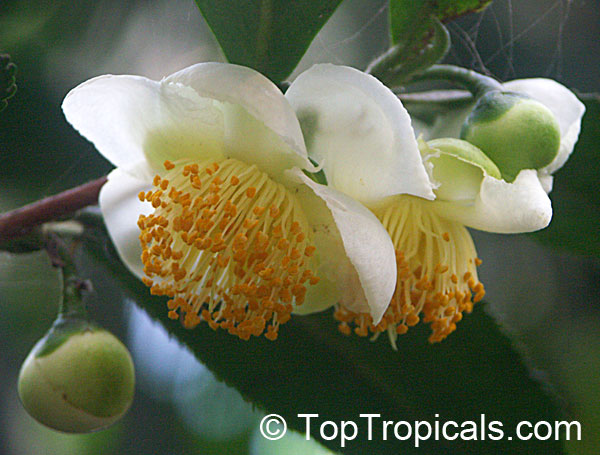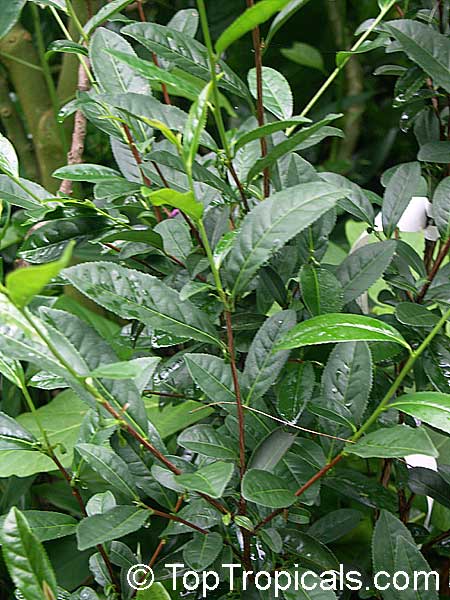A Cup of Tea Plant
by Onika Amell
About the Author
Onika Amell was born in farmer's family in Cape Town, South Africa, and always had a keen interest in gardening. She has been a globe-trotter for many years, traveling along with her husband, an engineer, and her life is worth a novel. In Cape Town she worked in groups “Soil for Life and Work for Love”, teaching people how to grow their own food, improve their health, and protect the environment. Onika lived in Galilee, Israel, skydiving over 500 jumps and working on the fields planting, harvesting and caring for various crops (Lychee, Avocado, Bananas, etc), helping out in community gardens... In SE Asia, she taught English at business centers... Upon finally settling in SW Florida, she joined the ECHO Global Farms project on teaching farmers/families around the world about effective crop production... Now as a part of Top Tropicals Team, Onika is our plant expert and a columnist. Onika's biggest passions are plants and... of course – cats, who are her children! She has six of them: Itembi, Freddie Mercury, Donald Trump (he is the difficult one), Tigerlilly, Sweetie, and Jaxson.
“A woman is like a tea bag - you can’t tell how strong she is until you put her in hot water.”
-
Eleanor Roosevelt
Most people do not realize they are actually enjoying camellias when they sip their cup of tea. True tea comes from the Camellia sinensis plant, an evergreen shrub or small tree.
In the fall and winter, the plant will produce small white flowers with a lovely fragrance. The foliage is shiny and dark green with a very nice informal and open look.
Camellia sinensis (or Tea Plant, as it is commonly known) prefers a temperature between 65 and 86 degrees, which makes Florida an ideal area to grow them. However, if you live in colder zones, you can certainly succeed growing your own tea plants using a greenhouse. Alternatively, you can use containers which can be brought inside when temperatures start falling. Tea plants will usually survive a slight freeze, though the leaves may be damaged. These plants prefer full sun or light shade in the garden.

Tea plants will become small trees or large bushes if not pruned. Hard core tea growers trim back the shoots repeatedly to a height of around 4 feet to encourage new growth and to contain the size.
Make sure to pick an area of your landscape where it does not flood or remain wet during our rainy season. Camellia sinensis do not like wet feet at all. They prefer well-drained, sandy and slightly acidic soil. If grown in a container, add some sphagnum moss to the potting mix. They will benefit from frequent applications of small amounts of fertilizer.
RECOMMENDED FERTILIZERS:
Tropical Greenhouse Plus - Plant Booster
Tropical Allure - Smart-Release Booster
You will need some patience, too. Your plant should be around 3 years old before you start harvesting leaves.

Tea Harvesting Recipes
Camellia sinensis is used to make green, oolong, black tea, and many other kinds of tea. The best tea is always made from freshly formed new leaves. A small tea plant can produce about a 1/2 lb of tea.
Green Tea
• Cut off twigs with 2-3 of the younger fresher leaves (first flush), then pull off the individual leaves.
• Pat the leaves dry, and place in a warm, shaded area for a few hours to totally dry.
• Steam the leaves on your stovetop for about a minute. Or roast them in a skillet for 2 minutes. Both methods will give a different flavor.
• Spread the leaves on a tinfoil covered baking sheet and dry them in the oven at 250 F for 20 minutes.
• Store the dried tea leaves in an air-tight container.
Japanese Style Green Tea
• Cut off twigs with 2-3 of the younger fresher leaves (first flush), then pull off the individual leaves.
• Roll the leaves long ways as tightly as possible between both hands to produce long twists of whole leaf.
• Place on a sheet of foil in a warm oven (below 245 degrees) for a maximum of 5 minutes. This dries the leaf and stops further fermentation. Be careful not to burn the leaves.
Oolong Tea
• Cut off twigs with 2-3 of the younger fresher leaves (first flush), then pull off the individual leaves.
• Spread them out on a towel under the sun and let them wilt for about 45 minutes. This step is called withering.
• Sit at room temperature for a few hours, stirring every hour.
• Spread the leaves on a tin foiled covered baking sheet and dry in the oven at 250F for 20 minutes.
• Store in an air-tight container.
Black Tea
• Cut off twigs with 2-3 of the younger fresher leaves (first flush), then pull off the individual leaves.
• Roll the leaves between your hands, and crush them until the leaves start to darken and turn red.
• Spread them out on a tray, and leave them in a cool location for 2-3 days. Dry them in the oven at 250 F for about 20 minutes.
• Store in an air-tight container.
Orthodox Indian Tea
• Cut off twigs with 2-3 of the younger fresher leaves (first flush), then pull off the individual leaves.
• Roll the leaves in a circular motion using both hands. Press together as hard as possible to crush and break the leaves.
• Put the leaves in a paper bag for a day or two to ferment and lose some of their “greenness” and to develop a drier tea character.
• Remove and stalk and stem, roll briefly, and dry on a sheet of foil in a warm oven (below 245 degrees) for a maximum of 5 minutes.
• Store in an air-tight container.
Brewing
Use about one teaspoon of leaves per cup. For green tea, add hot water and let it steep for two to three minutes. For oolong tea, use water that is close to boiling and let it steep for five to eight minutes. And for black tea, use almost boiling water and steep for three to five minutes. Never let tea sit for too long. It will become bitter. Experiment a little bit. Try different drying times - it will give you different flavors.
I personally enjoy surprising my quests with post dinner mint tea - the tea and the mint (Kama Sutra Menta) all grown in my very own garden. I serve it in dainty, bejeweled Moroccan tea
glasses, with tiny spoons and honey to sweeten.
Sit back. Sip. Savour. Swallow. Sigh. Repeat.

